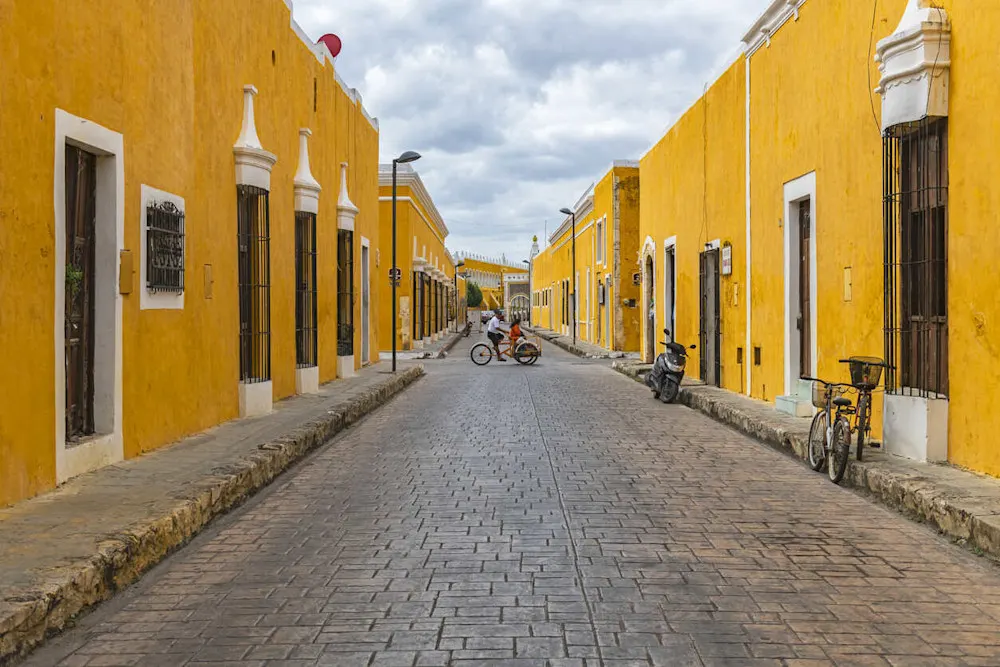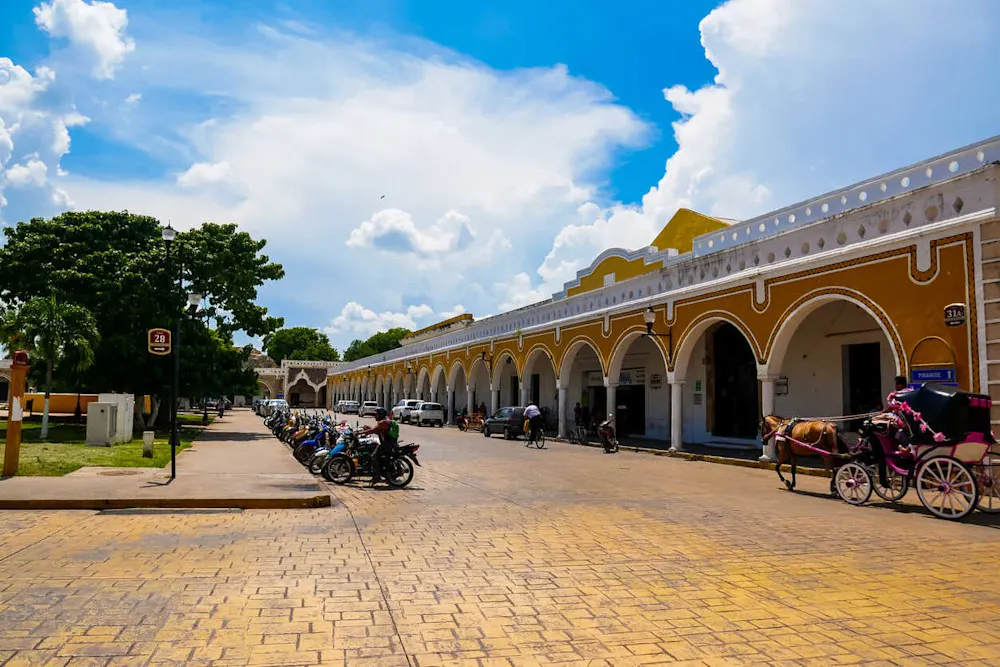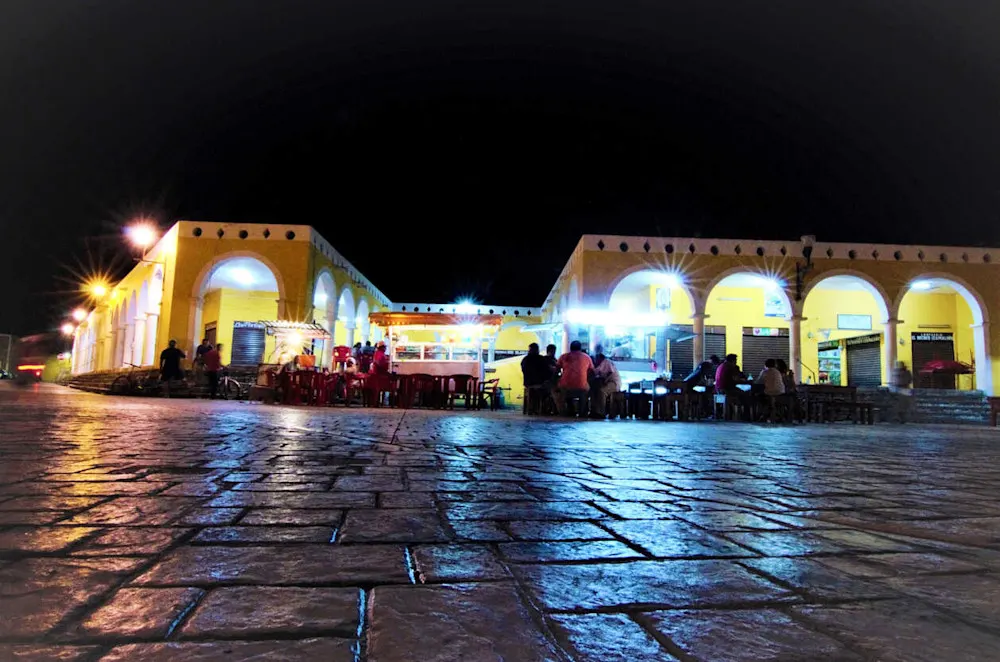When I first heard about Izamal—the Ciudad de Amarillo, or “Yellow City”—my ears perked up. I leaned forward and said, “Tell me more.” A small Mexican town filled with yellow buildings? Yes, please. The photos showed a quaint, historic pueblo (town), with every building painted the same honey-colored yellow.
Months later, after a five-hour road trip from Playa del Carmen, we approached the Pueblo Mágico, or “Magic Town,” of Izamal. We took the smooth toll road through miles of flatland interspersed with jungle, and finally emerged into a postcard-perfect scene: ochre-yellow buildings lining narrow, cobblestone streets. The contrast between the golden walls and the bright blue sky gives the whole town a cheerful, storybook quality.
But like many towns in Mexico, Izamal has a complicated past. The Spanish conquest left a lasting mark on this once-Mayan stronghold, creating an intricate blend of Mayan and Spanish history that spans over a thousand years.
To truly appreciate Izamal, it helps to understand the town’s layered story. Why is there a picturesque yellow town in the middle of the Yucatán?
Get Your Free Mexico Report Today!
Get Your Free Mexico Report Today!
Learn more about Mexico and other countries in our daily postcard e-letter. Simply enter your email address below and we’ll send you a free special report – Mexico: The Perfect Close-to-Home Retirement Haven.

By submitting your email address, you will receive a free subscription to IL Postcards, Overseas Dream Home, The Untourist Daily and special offers from International Living and our affiliates. You can unsubscribe at any time, and we encourage you to read more about our Privacy Policy.
Izamal’s History

Before the Spanish arrived with their mission to convert the world to Catholicism, the Maya had their own long-standing traditions and deep roots in the region.
Historians estimate that this intriguing town is around 2,000 years old. Between 600 and 800 CE, the ancient Maya built six pyramids in and around what is now Izamal. These structures were part of a vast network of Mayan communities stretching across the Yucatán Peninsula. Izamal is just 43 miles from Chichén Itzá—the most famous of these archaeological sites.
UNESCO notes that Izamal’s name likely refers to a “hill,” while other sources suggest it relates to the ancient Mayan god Itzamná. Regardless of its origin, the arrival of the Spanish in the 1550s dramatically altered the town’s history.
In a pattern repeated across Mexico, the Spanish army destroyed the tallest pyramid—known in Maya as Pop-hol-Chac—and repurposed its stones to build a Catholic church and convent. Today, the Convent of San Antonio de Padua stands as one of Izamal’s most iconic landmarks.
The convent rises from the surrounding streets, drawing your eye upward and inviting you in via a wide cobblestone ramp. Once you pass through the arched entrance, you find yourself in a vast atrium framed by seventy-six yellow arches trimmed in white—forming the second-largest enclosed atrium in the world, after St. Peter’s Square in Vatican City.
In the 1560s, Franciscan monks installed an image of the Virgin of the Immaculate Conception inside the church, making it a pilgrimage site that continues to draw the faithful to this day.
Every December, Izamal hosts an annual feast in honor of Our Lady of the Immaculate Conception, blending Catholic and Mayan traditions. The celebration includes flower-strewn processions, traditional Maya dance performances, homemade altars throughout town, and, of course, plenty of food and drink.
In 1993, Pope John Paul II visited Izamal, further solidifying its importance within the Catholic tradition.
After visiting the convent, you can stroll a few blocks to connect with pre-Hispanic history at the pyramid of Kinich Kak Moo. This ancient structure, standing at roughly 112 feet, is said to be the highest point in the Yucatán. If you’re feeling adventurous, you can climb to the top and take in sweeping 360-degree views of Izamal’s golden buildings and the surrounding countryside.
And if you’re not up for the climb? No problem. You can still enjoy a refreshing mango-flavored popsicle or a scoop of ice cream at the base—just as satisfying, in its own way.
Why is the Town Yellow?

The history and architecture make Izamal a fascinating place to visit—but the question on everyone’s mind is always: “Why yellow?” Few other Mexican towns have gone to such lengths to coordinate their appearance.
Unfortunately, the real reason is lost to history. Some say the town’s vibrant hue honors the Mayan god Itzamná, who represents the sun and wisdom. Others claim the buildings were painted yellow to welcome the Pope’s visit.
Whatever the origin, the result is a rich, warm color that feels inviting and makes for an undeniably charming setting.
Despite its “city” moniker, Izamal is home to just around 20,000 people—many of whom are of Mayan heritage. It’s not overrun with tourists, though we certainly weren’t the only visitors there. Situated roughly halfway between the Yucatán capital of Mérida and the iconic ruins of Chichén Itzá, Izamal makes for a wonderful afternoon stop or even an overnight stay, thanks to its many small hotels.
Tacos, Textiles, and Tradition in Izamal

At the heart of town is a peaceful square with paved pathways and benches where you can rest and enjoy snacks from local vendors—think peanuts, popcorn, or cold drinks. Around the plaza, small shops offer a mix of artisanal goods, such as henequén (sisal) weaving, and local eateries and convenience stores where you can grab a bottle of water or a quick bite.
During the day, a large open-air market buzzes with activity. Locals crowd the Municipal Market for fresh fruits and vegetables—but if you’re visiting, your first stop might be the taco vendor stationed at the entrance.
The day we visited, the vendor offered five or six different taco fillings, along with condiments like pickled onions and homemade salsas. A word of caution: Mexican salsas range from mildly spicy to blow-your-head-off hot. Point to what you want, and the ladies behind the counter will serve your tacos on small, plastic-covered plates. You can stand to eat or, if there’s space, sit on one of the plastic stools in front of the stand. It’s fast, flavorful, and perfect for a quick lunch.
If you’re after a sit-down experience, Izamal has that too. Restaurant Kinich is a local favorite, known for its traditional Yucatecan dishes served under a shady palapa roof. Sopa de lima (lime soup) and cochinita pibil (a slow-roasted, marinated pork dish) are standout choices.
A Perfect Day Trip—or More
Just five hours from Cancún and Playa del Carmen—and only about an hour from Mérida—Izamal is a perfect day trip or weekend getaway if you’re exploring the region. Its golden walls, rich heritage, and relaxed pace will stay with you long after you’ve left.
Get Your Free Mexico Report Today!
Get Your Free Mexico Report Today!
Learn more about more cost-effective healthcare options in Mexico and other countries in our daily postcard e-letter. Simply enter your email address below and we’ll send you a free special report – Mexico: The Perfect Close-to-Home Retirement Haven.

By submitting your email address, you will receive a free subscription to IL Postcards, Overseas Dream Home, The Untourist Daily and special offers from International Living and our affiliates. You can unsubscribe at any time, and we encourage you to read more about our Privacy Policy.
